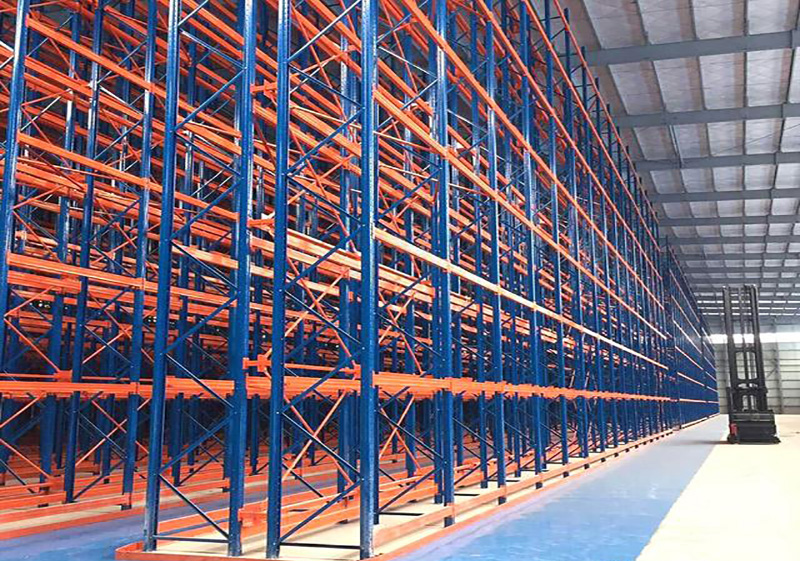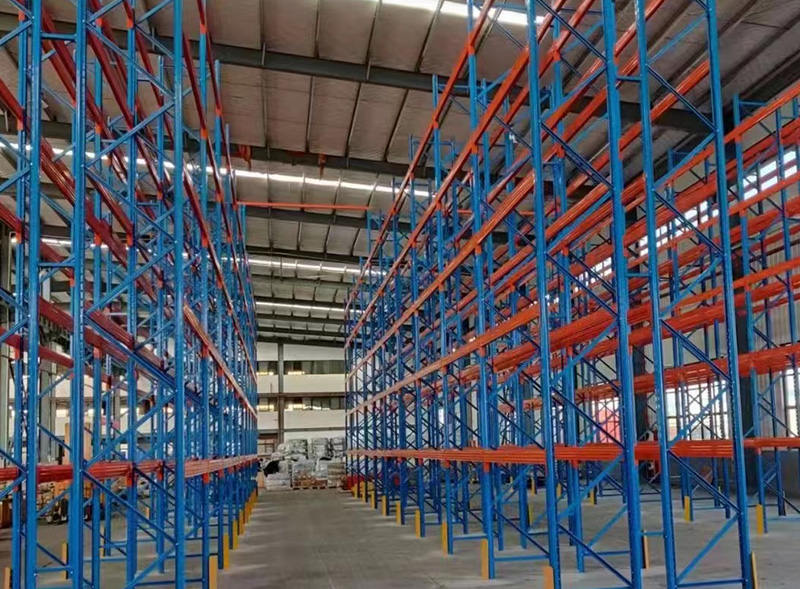n the relentless pursuit of operational efficiency, warehouse managers, logistics professionals, and business owners constantly seek solutions to maximize space, streamline workflows, and protect valuable inventory. Among the most fundamental and impactful investments for achieving these goals is pallet shelving. Often the backbone of industrial storage, pallet shelving systems provide the robust framework needed to store goods safely, accessibly, and systematically. But what exactly is pallet shelving, and why is it so crucial? This comprehensive guide dives deep into five key aspects, empowering you to make informed decisions for your storage needs.

What is Pallet Shelving? (The Foundation of Industrial Storage)
Pallet shelving, also frequently referred to as pallet racking, is a specialized type of industrial shelving system explicitly designed to store unitized loads, most commonly stacked on standard pallets (typically 48" x 40" in North America, but sizes vary globally). Unlike lighter-duty shelving, pallet shelving is engineered to handle significant weight capacities – often thousands of pounds per shelf level – and is characterized by its open structure, accessibility via forklifts or pallet jacks, and modular design.
The core components of a typical pallet shelving system include:
Upright Frames: Vertical columns, usually made of heavy-gauge steel, that form the main support structure. They feature punched holes or slots for adjustable beam placement.
Beams: Horizontal members that connect to the uprights and directly support the pallet loads. They come in various lengths, depths, and weight capacities.
Wire Decking, Plywood, or Steel Pallet Supports: Surfaces placed on the beams to provide a stable base for the pallets and prevent them from falling through. Wire mesh is popular for visibility, fire safety, and debris fall-through.
Row Spacers & Braces: Optional components that enhance stability, especially for tall systems or multiple rows.
The Indispensable Benefits of Pallet Shelving Systems
Investing in the right pallet shelving delivers a multitude of tangible advantages that directly impact your bottom line and operational effectiveness:
Maximized Vertical Space Utilization: Warehouses pay a premium for square footage. Pallet shelving's primary function is to exploit the often-underutilized vertical cube of a building. By stacking pallets safely multiple levels high, you drastically increase storage density without expanding your physical footprint. This translates directly into reduced real estate costs per stored pallet.
Enhanced Accessibility & Inventory Management: Well-designed pallet shelving systems facilitate direct access to every pallet stored (especially in selective rack configurations). This First-In, First-Out (FIFO) or even Last-In, First-Out (LIFO) capability is vital for inventory control, reducing stock obsolescence, and ensuring efficient picking operations. Forklifts can navigate aisles to reach specific pallets quickly.
Improved Organization & Workflow: A structured pallet shelving system brings order to chaos. Pallets are stored systematically, often organized by SKU, product type, or shipment date. This organization minimizes search times, reduces picking errors, speeds up order fulfillment, and creates safer, less congested pathways for material handling equipment.
Robust Durability & Safety: Engineered from high-strength steel and designed to meet rigorous industry standards, quality pallet shelving provides a safe and secure environment for your valuable inventory. Properly specified and installed systems prevent load collapses, protect goods from damage caused by improper stacking or handling, and create a safer workplace by keeping aisles clear and loads stable. Features like load beams locks and column protectors enhance safety further.
Cost-Effectiveness & Scalability: Compared to the cost of expanding a building or leasing additional space, pallet shelving offers a highly economical storage solution. Its modular nature is a significant advantage; systems can easily be reconfigured, expanded, or even relocated as your storage needs evolve. You start with what you need and add on seamlessly, protecting your initial investment over the long term.

Exploring the Common Types of Pallet Shelving
Not all pallet shelving is created equal. Different types are designed to address specific storage challenges, space constraints, and inventory access requirements:
Selective Pallet Racking: The most common and versatile type. It features a simple design with parallel rows of upright frames connected by beams, creating individual bays accessible from an aisle. Every pallet is directly accessible, making it ideal for facilities handling a wide variety of SKUs requiring frequent access (FIFO). It offers maximum flexibility but requires wider aisles for forklift access.
Drive-In/Drive-Thru Pallet Racking: Designed for high-density storage of large quantities of the same product (LIFO or FIFO). Forklifts actually drive into the rack structure itself on rails placed on the floor. Pallets rest on rails mounted to the uprights. Drive-In (access from one end) is typically LIFO, while Drive-Thru (access from both ends) allows FIFO. Maximizes cube utilization but reduces selectivity and requires specialized forklift operation.
Push-Back Pallet Racking: A dynamic high-density system operating on a Last-In, First-Out (LIFO) basis. Pallets are loaded on inclined carts nested on rails behind each other. When a new pallet is loaded, it pushes the existing pallets back. When unloading, the next pallet automatically rolls forward. Offers good density (typically 2-6 pallets deep) with better selectivity than drive-in systems.
Pallet Flow Pallet Racking: A dynamic high-density system operating on a First-In, First-Out (FIFO) basis. Pallets are loaded onto an inclined rail system at the "back" (higher end) and flow by gravity towards the "front" (lower end) unloading position. Ideal for perishable goods or items with strict expiration dates requiring perfect FIFO rotation. Requires careful load balancing and compatible pallets.
Cantilever Pallet Racking: Specifically designed for storing long, bulky, or awkwardly shaped items that don't fit standard pallet racking easily, such as lumber, pipes, furniture, or rolls. Features vertical columns (cantilever uprights) with horizontal arms extending outwards. Offers unobstructed front access along the entire length of the item. Not typically used for standard palletized loads.
Critical Considerations Before Buying Pallet Shelving
Selecting the right pallet shelving system is not a one-size-fits-all proposition. Careful planning and analysis are essential:
Assess Your Load Requirements: This is paramount.
Pallet Size & Weight: Precisely measure your typical pallet dimensions (length, width, height) and know the maximum weight per pallet (including the pallet itself). Be realistic about potential future weights.
Beam Capacity: The beams must be rated to support the combined weight of the pallet load and the decking/supports on each level. Always include the weight of the decking! Choose beams with a capacity exceeding your maximum anticipated load.
Upright Frame Capacity: The upright frames must support the cumulative weight of all pallet loads, beams, and decking on each bay. Calculate the total weight per bay per level and ensure the uprights' capacity rating is sufficient. Consider potential uneven loading.
Analyze Your Space & Layout:
Building Dimensions: Measure ceiling height (clear height), floor space (length and width), and identify any obstructions (columns, doors, sprinklers, HVAC).
Aisle Width: Determine the turning radius of your material handling equipment (forklift type - counterbalance, reach truck, turret truck). This dictates the minimum aisle width required for selective racking. High-density systems (Drive-In, Push-Back, Flow) require narrower aisles.
Racking Configuration & Row Spacing: Plan the number of rows, bays per row, and the number of levels. Ensure adequate clearance between the top pallet and sprinkler heads (usually min. 18") or lights. Factor in beam depth and decking overhang.
Understand Inventory Profile & Access Needs:
SKU Count & Variety: Do you need access to many different SKUs (favors selective racking) or large quantities of fewer SKUs (favors high-density)?
Turnover Rate & Picking Frequency: Fast-moving items benefit from accessible locations (often ground level or easily reached levels in selective racking). Slow-moving items can be stored higher or in denser configurations.
FIFO vs. LIFO Requirements: Does your inventory require strict rotation (FIFO for perishables) or is LIFO acceptable (e.g., non-perishable bulk items)? This heavily influences the type of pallet shelving chosen (Flow vs. Push-Back/Drive-In).
Prioritize Safety & Compliance:
Seismic Requirements: If in an earthquake-prone zone, specific engineering and bracing are mandatory.
Building Codes & Fire Regulations: Ensure the system design complies with local building codes and fire department regulations regarding clearances, sprinkler coverage, and potential use of wire decking.
Safety Accessories: Budget for essential safety features: column protectors (to guard uprights from forklift impact), pallet supports/wire decking (to prevent pallets from falling), beam locks (to prevent beams from being accidentally dislodged), and aisle-end guards.
Professional Design & Installation: Always engage reputable suppliers and installers. Proper engineering, anchoring, and installation are critical for structural integrity and safety. Obtain a load application and rack configuration (LARC) drawing.
Installation, Maintenance & Best Practices for Pallet Shelving
Proper implementation and ongoing care are vital for the longevity, safety, and performance of your pallet shelving system:
Professional Installation: Never attempt a DIY installation for pallet shelving. Certified installers ensure:
Correct assembly according to manufacturer specifications and engineering drawings.
Proper anchoring to the floor (essential for stability, especially in seismic zones or for tall racks).
Accurate leveling and alignment.
Verification of load capacities and safety features.
Routine Inspections & Maintenance: Implement a formal inspection program:
Daily/Operator Checks: Encourage forklift operators to report any observed damage immediately (hits, dents, bent components).
Scheduled Visual Inspections: Conducted weekly or monthly by trained warehouse personnel. Look for obvious damage, loose bolts, shifted beams, damaged decking, or leaning frames.
Formal Annual Inspections: Performed by a qualified rack inspector (internal certified person or external specialist). A thorough, documented inspection checking for plumb, damage levels, beam connections, anchor integrity, safety devices, and overall condition against the original specifications. RMI (Rack Manufacturers Institute) standards provide excellent guidelines.
Safe Loading & Unloading Practices:
Never Exceed Capacity: Strictly enforce maximum load limits per beam level and per bay. This is non-negotiable.
Use Compatible Pallets: Ensure pallets are in good condition and sized correctly for the beam spacing. Avoid damaged pallets.
Center Loads: Position pallets squarely and centered on the beams/decking. Avoid overhang.
Use Decking/Pallet Supports: Always use appropriate decking or pallet supports. Never place pallets directly onto beams.
Avoid Side Loads: Train forklift operators to handle loads carefully to prevent impacts on the rack structure. Drive straight in and out.
Damage Protocol: Have a clear procedure:
Immediately remove any load from a damaged section.
Clearly mark the damaged bay as "Out of Service" (DO NOT USE).
Report the damage to management.
Engage a qualified rack inspector or engineer to assess the damage and recommend repair or replacement. Never attempt makeshift repairs.
Pallet shelving is far more than just metal frames and beams; it's a strategic investment that underpins efficient, safe, and cost-effective warehouse operations. By understanding its core definition, appreciating its multifaceted benefits, navigating the diverse types available, meticulously considering critical purchase factors, and committing to proper installation and rigorous maintenance, you unlock its full potential.
Choosing the optimal pallet shelving system – whether it's versatile selective racking for maximum accessibility, high-density drive-in for bulk storage, dynamic push-back for efficient LIFO, precise pallet flow for FIFO perishables, or specialized cantilever for long loads – directly translates into tangible gains: maximized space utilization, accelerated workflows, enhanced inventory control, reduced product damage, and a safer working environment.
Don't leave your warehouse storage to chance. Carefully evaluate your specific needs, consult with reputable pallet shelving suppliers and engineers, and implement a system designed for safety, efficiency, and scalability. The right pallet shelving solution is the foundational step towards a streamlined, productive, and profitable logistics operation.







